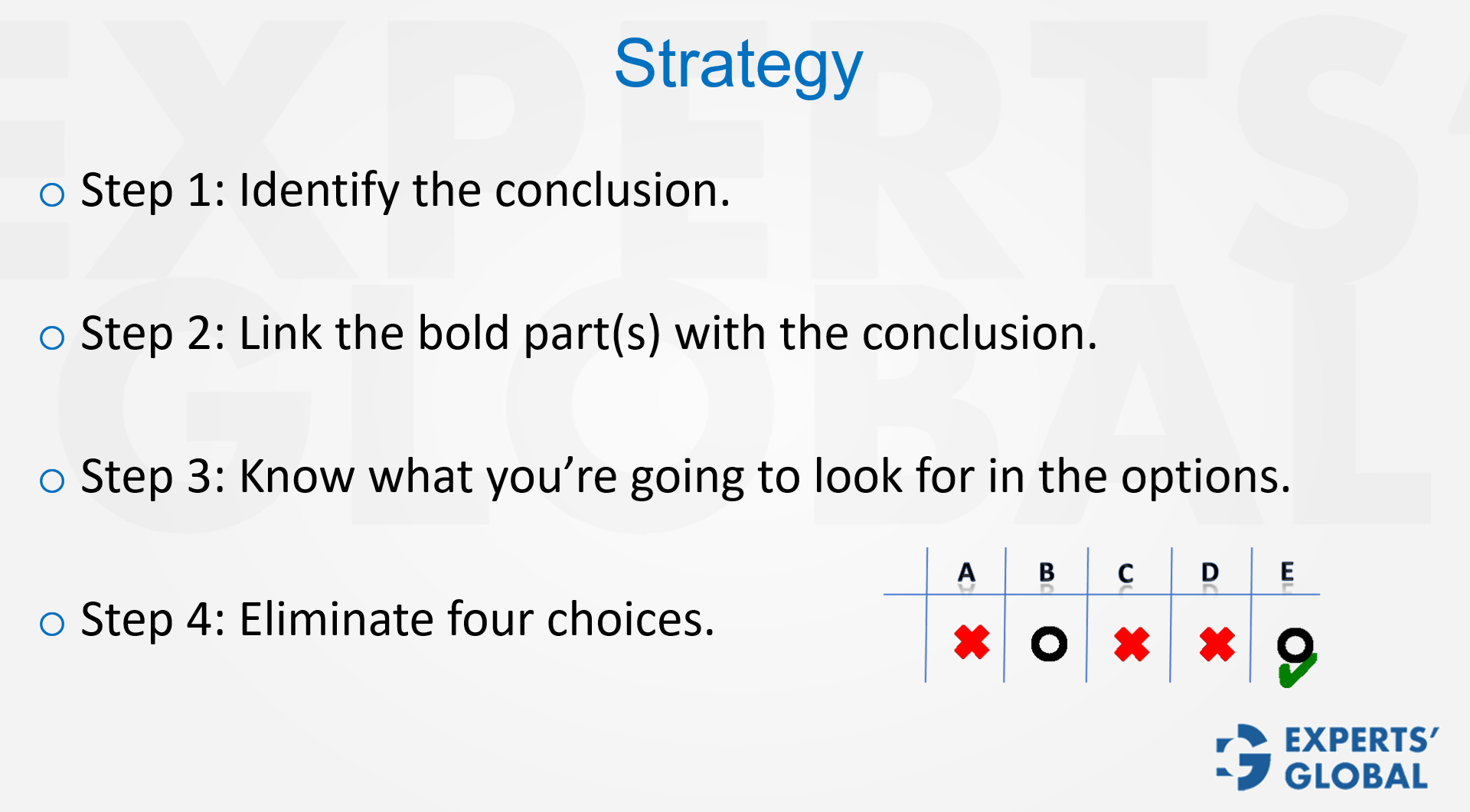Invest 30 seconds...
...for what may lead to a life altering association!
Help Line
- +91.8800.2828.00 (IND)
- 1030-1830 Hrs IST, Mon-Sat
- support@expertsglobal.com
...for what may lead to a life altering association!


GMAT Critical Reasoning Boldface questions are an important part of the GMAT preparation course of every serious candidate. In these questions, you are given a short passage with one or more portions in boldface, and your task is to choose the answer that best explains the role those boldface portions play in the argument. The correct approach is to first identify the conclusion of the argument, then link each boldface with the conclusion, thereafter set a broad expectation from the correct answer choice, and then proceed by elimination. After eliminating four options, confirm that everything is consistent with the remaining choice before marking it. One of the biggest challenges in Boldface questions is the complex vocabulary involved, so adequate practice on the vocabulary frequently tested in GMAT CR is an important part of the preparation. We will undertake five vocabulary tests for GMAT CR; this article presents the first test. Please watch the video carefully and then go through the detailed textual explanation that follows.

In GMAT boldface questions, a passage will be provided that has one or more portions in boldface. The question will be to determine what role those portions play in the passage. Considering the complex vocabulary of the boldface questions and the importance of properly identifying the role that each bolded section plays, it would be good to go through a few vocabulary tests on the same.
Please read the following paragraph, carefully:
The GDP of Xitora has grown by 15% during the tenure of the current political party. This is the highest growth during any tenure over the previous 50 years. Since the GDP growth is a fine indication of the economic growth of a nation, the party must be applauded for its role. However, the recent opinion polls reflect a steep decline in the popularity of the party owing to its perceived softness on long-standing social and diplomatic issues. Therefore, the party is unlikely to win another term in the forthcoming elections.
Please go through the following list of terms. See which of these terms apply to the bolded portion. Once you have arrived at your answer, read further to see an explanation for each option.
GDP growth has been great –> party deserves credit –> party has been soft on other issues –> the party is not likely to win (main conclusion)
The bolded portion is definitely not a conclusion of any kind; it is plainly stating a fact.
As mentioned above, the bolded portion is not a conclusion of any kind.
This is a very appropriate way to describe the bolded portion, as it is clearly stating a fact.
This is not an appropriate label for the bolded portion, as the information is presented as a hard fact, not someone’s opinion.
This label does not fit; a judgment reflects a value assessment, whereas the bolded portion reports a concrete fact.
This is a fitting label for the bolded portion.
The bolded portion can be described as evidence in certain other contexts, but in this passage that is not the role it plays.
This is not the right choice, as the bolded portion does not make any inferences.
This is incorrect because, as stated earlier, the bolded portion conveys a concrete fact.
Yes, this bolded portion could be called a consideration under most circumstances. However, in this reasoning, the bolded portion does not play the role of consideration.
At first glance, the GDP growth figure may seem like “evidence.” However, in this argument, it is not directly being used to support or refute another claim. Instead, it is presented as a factual background. In another argument, the same data might indeed serve as evidence, but in this particular reasoning, its role is limited to being a fact or finding.

Boldface questions in GMAT Critical Reasoning often intimidate students because of their heavy use of logical vocabulary and their seemingly complex answer choices. However, when approached with clarity and structure, these questions are among the most logical and consistent question types on the exam.
Boldface Critical Reasoning is more than a vocabulary check. It is a habit of mind. You pause, find the conclusion, test each piece, and accept only what fits. That is GMAT preparation at its best. The same discipline powers MBA applications. You gather achievements, weigh weaknesses, and let a clear story emerge. Life rewards the same clarity. Facts are not feelings, and judgments deserve evidence. When you link actions to outcomes, you build trust. When you eliminate noise, you make room for purpose. Keep returning to the argument within. It will teach you to think, to choose